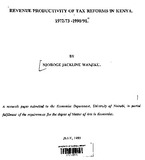Revenue productivity of tax reforms in Kenya. 1972/73 -1990/91
| dc.contributor.author | Njoroge, Jackline W | |
| dc.date.accessioned | 2016-06-21T15:03:47Z | |
| dc.date.available | 2016-06-21T15:03:47Z | |
| dc.date.issued | 1993-06 | |
| dc.identifier.uri | http://hdl.handle.net/11295/96239 | |
| dc.description.abstract | Under the threat of fiscal crises, many developing countries have had to make projections of additional revenues that can be realized within the existing tax structures. These projections indicate the need to activate additional means of revenue generation. Tax reforms have been on the agenda of many developing countries. Whereas the tax system may be utilized for other economic purposes revenue generation still remains one of the major objectives that a tax system ought to serve. The paper sets out to establish the revenue productivity implications of tax reforms in Kenya using elasticity and buoyancy models. It was found out that the tax system has not been elastic with respect to income. However discretionary measures have been utilized variously in order to meet the revenue requirements. Economic policies being pursued have at times been in conflict with the requirement of revenue generation. Further measures thus have to be continuously adopted in order for the system to respond more adequately to revenue generation. This is more important now in view of raising expenditures and reduced donor funding. | en_US |
| dc.language.iso | en | en_US |
| dc.publisher | University of Nairobi | en_US |
| dc.rights | Attribution-NonCommercial-NoDerivs 3.0 United States | * |
| dc.rights.uri | http://creativecommons.org/licenses/by-nc-nd/3.0/us/ | * |
| dc.title | Revenue productivity of tax reforms in Kenya. 1972/73 -1990/91 | en_US |
| dc.type | Thesis | en_US |



